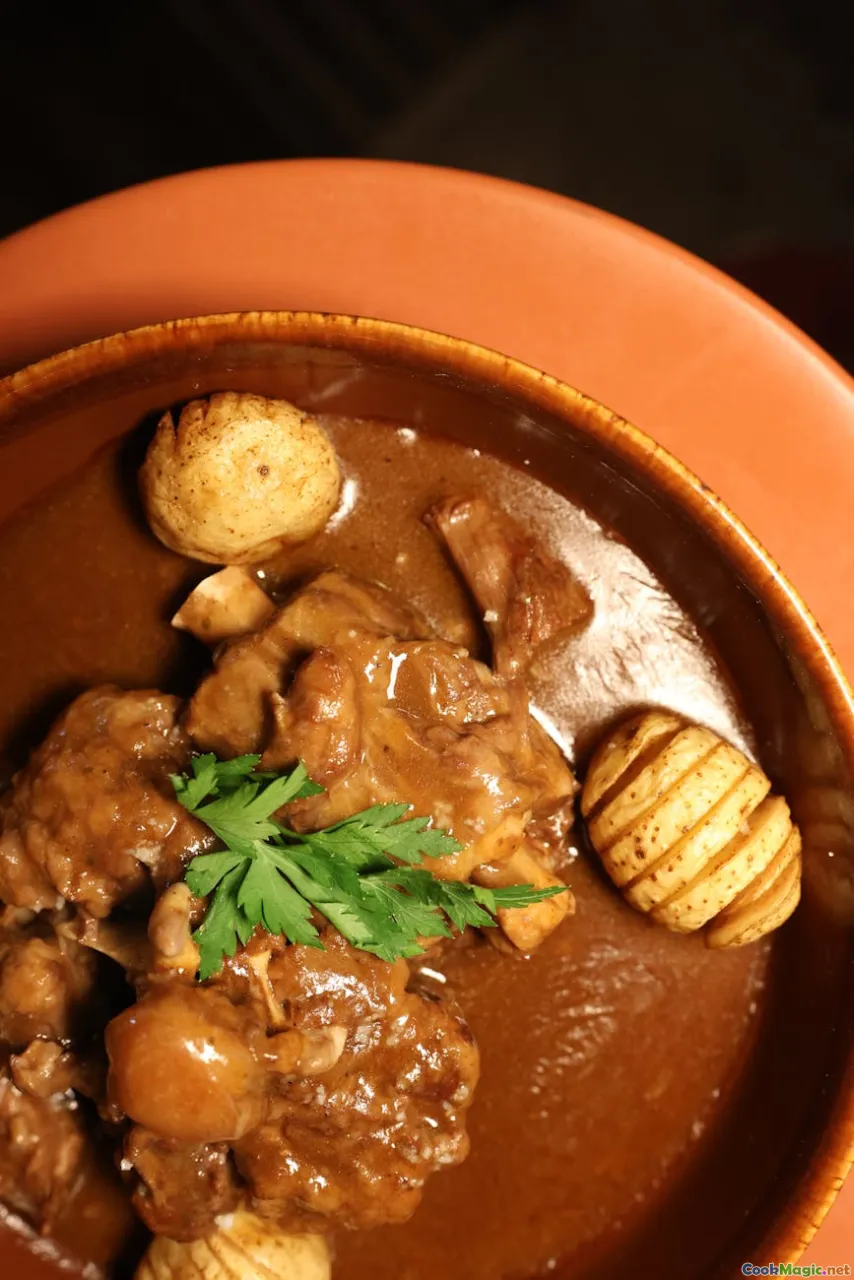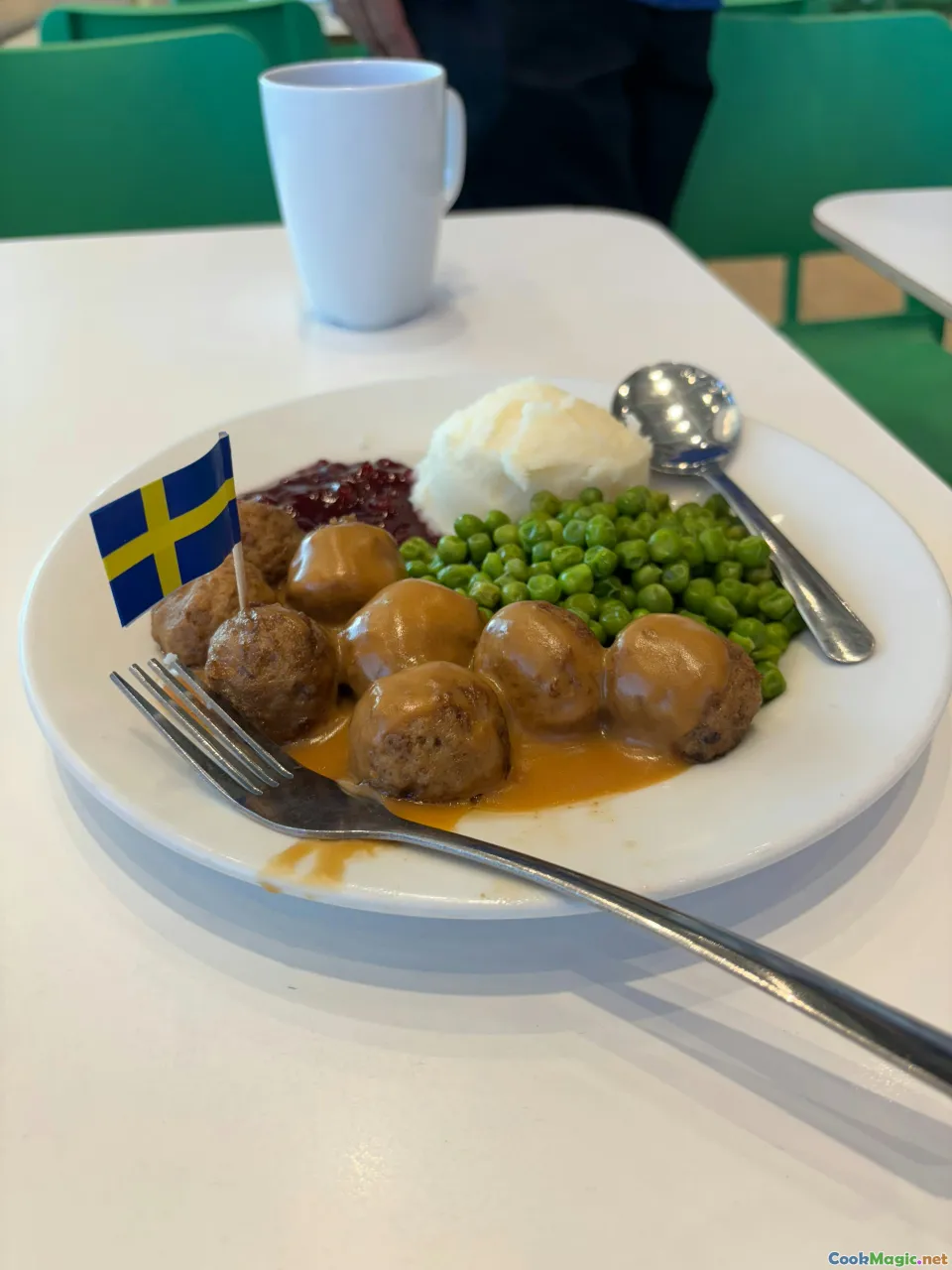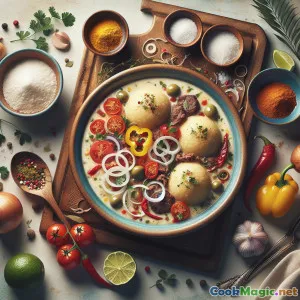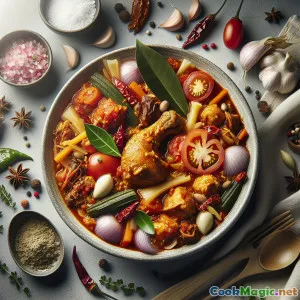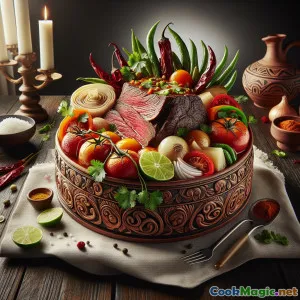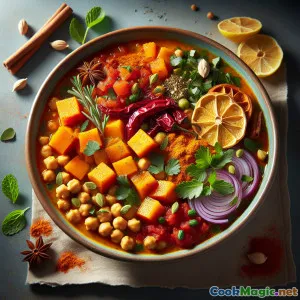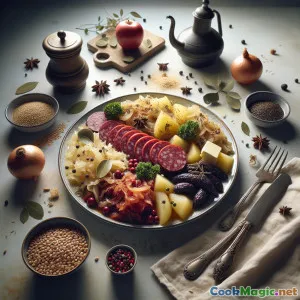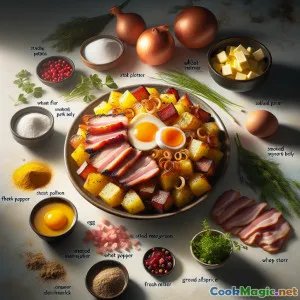
स्मालैंडेट्स क्रॉप्काक्सग्यट्रा - स्वीडिश डम्पलिंग स्टू
(Smalandets Kroppkaksgryta - Swedish Dumpling Stew)
(0 समीक्षाएँ)सामग्री
-
600 grams स्टार्ची आलू
(Peeled and coarsely grated, e.g., Russet)
-
130 grams गेहूँ का आटा
(Plain flour)
-
1 large अंडा
(Free-range recommended)
-
1.5 tsp नमक
-
175 grams स्मोक्ड पोर्क बेल्ली
(Cubed; or use lightly salted pork)
-
1 medium पीला प्याज
(बारीक कटा हुआ)
-
0.5 tsp सफेद मिर्च
-
1 tsp सूखा मिंट
-
3 tbsp ताज़ा डिल
(कटा हुआ)
-
2 tbsp नमक रहित मक्खन
-
500 ml पूर्ण दूध
-
750 ml चिकन स्टॉक
(कम सोडियम)
-
0.25 tsp ऑलस्पाइस (पिसा हुआ)
-
4 tbsp लिंगोनबेरी जैम
(परोसने के लिए, वैकल्पिक)
(Peeled and coarsely grated, e.g., Russet)
(Plain flour)
(Free-range recommended)
(Cubed; or use lightly salted pork)
(बारीक कटा हुआ)
(कटा हुआ)
(कम सोडियम)
(परोसने के लिए, वैकल्पिक)
पोषण
- परोसने की संख्या: 4
- सेवा आकार: 1 bowl (approximately 300g)
- Calories: 550 kcal
- Carbohydrates: 72 g
- Protein: 20 g
- Fat: 21 g
- Fiber: 6 g
- Sugar: 7 g
- Sodium: 1240 mg
- Cholesterol: 52 mg
- Calcium: 142 mg
- Iron: 3 mg
निर्देश
-
1 - Prepare Potato Dumpling Dough:
Grate the potatoes finely, wring out excess liquid in a towel. Combine with flour, beaten egg, and 1 tsp salt to form a soft, non-sticky dough. Set aside.
-
2 - Prepare Filling:
Sauté chopped pork belly and onion in 1 tbsp butter until golden. Season with half the white pepper, the marjoram, and half the fresh dill. Cool for 5 mins.
-
3 - Form Dumplings:
With damp hands, flatten a golf ball-sized lump of dough, add a teaspoon of pork-onion filling, wrap and seal into a round dumpling. Repeat until dough is used.
-
4 - Boil Dumplings:
Bring a large pot of salted water to a simmer (not boil). Gently drop dumplings in batches, cook until they float then simmer another 4-5 minutes. Transfer to a plate.
-
5 - Cook Stew Base:
Wipe out pan. Add 1 tbsp butter, heat gently, stir in remaining white pepper, allspice (if using), milk, and chicken stock. Warm without boiling and season with 0.5 tsp salt.
-
6 - Combine and Finish Stew:
Carefully add the dumplings into the stew base. Spoon over additional fresh dill, gently warm through for at least 8 mins until flavors meld. Avoid stirring vigorously.
-
7 - Serve:
Ladle stew, including broth and dumplings, into bowls. Serve with a spoonful of lingonberry jam and more dill on top, if desired.
Grate the potatoes finely, wring out excess liquid in a towel. Combine with flour, beaten egg, and 1 tsp salt to form a soft, non-sticky dough. Set aside.
Sauté chopped pork belly and onion in 1 tbsp butter until golden. Season with half the white pepper, the marjoram, and half the fresh dill. Cool for 5 mins.
With damp hands, flatten a golf ball-sized lump of dough, add a teaspoon of pork-onion filling, wrap and seal into a round dumpling. Repeat until dough is used.
Bring a large pot of salted water to a simmer (not boil). Gently drop dumplings in batches, cook until they float then simmer another 4-5 minutes. Transfer to a plate.
Wipe out pan. Add 1 tbsp butter, heat gently, stir in remaining white pepper, allspice (if using), milk, and chicken stock. Warm without boiling and season with 0.5 tsp salt.
Carefully add the dumplings into the stew base. Spoon over additional fresh dill, gently warm through for at least 8 mins until flavors meld. Avoid stirring vigorously.
Ladle stew, including broth and dumplings, into bowls. Serve with a spoonful of lingonberry jam and more dill on top, if desired.
स्मालैंडेट्स क्रॉप्काक्सग्यट्रा - स्वीडिश डम्पलिंग स्टू :के बारे में ज़्यादा जानकारी
Smalandets Kroppkaksgryta: A Homage to Swedish Comfort Dining
Few dishes are as satisfyingly hearty, historically rich, and imbued with cultural nuance as the humble Swedish kroppkaka—an incredibly unique potato dumpling traditionally filled with pork and onions. This recipe, Smalandets Kroppkaksgryta, adapts classic Småland kroppkakor into a soul-warming stew format, capturing the spirit of south-central Sweden’s homespun winter kitchen, where origins stem from agricultural ingenuity and a penchant for rich, earthly flavors.
The Story Behind Kroppkaka
Kroppkaka ("body cake") is itself an evocative name, hinting at sustenance during long, cold months when potatoes assumed center stage in every meal. In Småland, these pillowy dumplings, often specked with dill and allspice, take on a slightly sweet-and-savory manner. Traditionally, they are boiled and served simply with melted butter or, delightfully, with tart lingonberry preserves flashing their crimson on a white plate. It is common for communal kitchens to make ample quantities ahead for feasts or family gatherings.
A Unique Modern Twist: Turning Dumplings Into Stew
While conventional kroppkakor appear as individual dumplings, this recipe reimagines them nestled in a comforting, milky broth infused with herbs. Tender cubes of smoked pork create a meaty backbone; finishing with a hint of marjoram and sweet onion infuse deep flavors into every bite. The stew base is enriched subtly with stock and milk, reflecting Sweden's love of dairy, then brightened with fresh dill—a recurring theme in Swedish homes.
Cooking & Serving Tips
- Potatoes: Use starchy, floury potatoes for best texture; waxing potatoes lead to gluey dumplings.
- Squeezing: It's crucial to wring out as much liquid as possible from grated potatoes—this stops the dough becoming heavy or sodden.
- Shaping & Sealing: Keeping your hands lightly damp prevents sticking when forming dumplings. Be sure to seal tightly so none burst during simmering.
- Don’t Overboil: Simmer, not boil! Vigorous bubbling can break the dumplings apart.
- Lingonberry Jam: Always serve a spoonful for authentic flair—the tang offsets the richness beautifully.
- Layer in Your Own Touches: For a more lavish feast, some add chopped mushrooms or use game meats. For vegetarian twists, swap the pork filling with golden-fried oyster mushrooms and leeks.
Historical and Cultural Roots
The reliance on preserved meats and winter root vegetables is typical of old Swedish farmhouse kitchens trying to utilize ingredients beyond their fresh season. Before refrigeration, curing or lightly smoking pork belly was a wintertime necessity, and root vegetables like potatoes dominated the table. Småland and Gotland both have claims to variations of kroppkakor, with debate over usage of raw versus pre-boiled potatoes. This version stakes its claim as authentically Smålandish: raw potato dough, sweet pork, and a touch of dill.
Dairy and boiled meat were traditionally signs of hospitality in Sweden; offering kroppkakor was a mark of respect and generosity. Today, though store-bought versions abound, families frequently gather to produce kroppkakor for special occasions, holidays, or simply as a gesture of collective remembrance.
Personal Reflections & Unique Qualities
This stew warms not just the stomach but the heart—tender dumplings yield to a lilting bite of pork, while the herb-laden broth soothes with creamy mouthfeel and homey aromas reminiscent of rural kitchens. A shining testament to frugality turned into culinary brilliance, Smalandets Kroppkaksgryta reveals how everyday ingredients—potatoes, flour, onion, bits of cured pork—can become something simultaneously humble and extraordinary.
To prepare this dish is to participate in history: the repetitive motions of grating, seasoning, forming, and simmering reflect the way food has always been about showing care, keeping warm, and making the most of the pantry. Through this recipe, anyone can conjure—not just a hearty meal—but a little corner of Swedish winter, where the kitchen radiates fellowship and the landscape outside is painted in whites and golds.
“Mat är kultur, minnen och traditioner” (“Food is culture, memories, and traditions.”)
Try this broth-laden, dumpling-studded stew, and you’ll surely taste more than just potatoes and pork—you’ll savor Swedish hospitality at its core.

